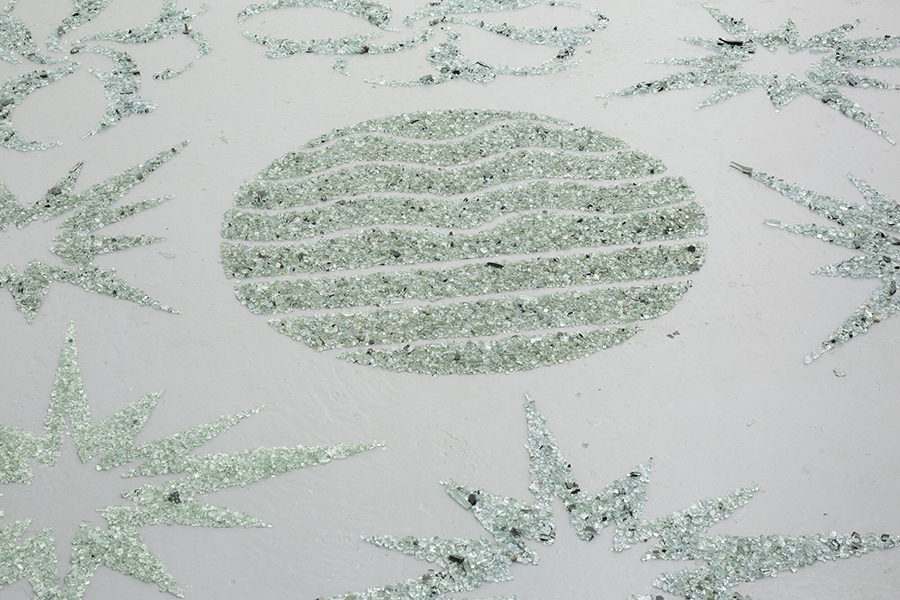She has been particularly engaged with the relationships between plastic, glass, air and the water condensed by machines utilized for climate control.
Image: Lauren Burrow,Nuisance flows, 2019. Photograph: Christian Capurro
Lauren Burrow
Burrow’s work investigates the histories of materials and narratives of resistance, and their contemporary resonance in parallel with her personal encounters with them. ‘In working with found materials, I try to understand how they register in seductive, aesthetic ways as much as they signify specific social or ecological relations where something is off-kilter or hidden,’ Lauren Burrow tells me. Since 2015, the artist has swept smashed glass from street gutters to bring back to her studio. At the opening of Lose the Language at Bus Projects that same year, her ice sculpture comprising water collected from public toilets melted to reveal the shards of shattered car windows. Since then, she has been particularly engaged with the relationships between plastic, glass, air and the water condensed by machines utilized for climate control.
At Holden Garage, Berlin, a series of plastic cups are strewn across the gallery floor. Across each cup, text announces I’M MADE FROM RECYCLING MATERIAL. Once tossed aside by marathon runners, they are filled with spit, water, dirt and leaves. Now, shards of broken safety glass encrust the lip of each cup. The installation, Warring feet (2022), evokes a chorus of breathless sips, urgent respite, wastefulness, exhaustion and then the visceral encounter of parched mouths to spiked challises.
In the artwork’s second staging in Munich at Pli, the cups were instead filled with drips from the gallery’s dehumidifier. The dematerialisation of breath and air across both iterations of the work gestures to attempts to control atmospheric conditions. Burrow considers this both in the broader world context of climate warming and in her own personal upbringing amid the dissonant self-made climates of air conditioners in the tropics.
By reformatting everyday detritus and making the ‘invisible’ (toilet water, breath, condensation) a dominant component of each work, Burrow challenges the notion of ‘seeing’ as the primary way of ‘knowing’ a place. Nuisance flows, presented in 2019 at TCB Art Inc, Melbourne, for example, engaged with pharmaceutical pollution taking place across our waterways. The exhibition honed in on how antidepressants excreted into our waterways can reduce predator-avoidance behavior in fish, thereby making them more vulnerable to prey. Glittering blue and green glass fragments mixed with ruddy-brown chunks of eucalypt resin were delicately arranged across the floor to create pharmaceutical logos. Adjacent, an upended stormwater grate positioned viewers on the underside of the drain. Also disorientating, strips of toilet paper mounted overhead and scrawled with permanent marker read: bad moods, vagueness, reluctance to interpolate, deanthropomorphised mouth, antidepressed fish. Here, through radical-empathetic encounters with materials, the complex flow-on ecological impacts of human affliction are brought to the fore.
During a residency at the NT’s Territory Wildlife Park, Burrow conducted research on the experience and writings of Val Plumwood, an Australian philosopher and ecofeminist. Plumwood’s near-death attack by a crocodile fueled her writings against anthropocentrism and for a reappraisal of our relationship to nature. In vivid retellings of the attack, Plumwood described a revelatory experience of the world from ‘the outside’: a world indifferent to her life or death.
Presented at the Australian Centre of Contemporary Art, Melbourne, as part of A Biography of Daphne, A stick developing eyes (2021) deconstructs Plumwood’s violent encounter. Five hundred resin crocodile eyes peer out from black, glittering, circular trays filled with water. An upright, freestanding sculpture references impressions of trees on Plumwood’s property and recalls the philosopher peering down upon the ‘centrifuge of boiling blackness’.
While Burrow cannot claim a near-death experience, she was born and raised in Darwin on Larrakia lands, where everyday life is punctuated by encounters with wildlife and at the whim of extreme weather events. ‘Spending time there is like a kind of protracted epiphany when it comes to nature,’ she says. Today, her practice expands beyond the studio. As a member of the Plumwood Committee, she is responsible for care of the 120-hectare Plumwood Mountain on the Walbunja lands of the Yuin Nation, home of the eminent Plumwood herself. Burrow’s Samstag Scholarship will also see her deepen her enquiries into Environmental Philosophy and engage in the history of the international saltwater crocodile skin trade.
An essay by Emma O’Neil following conversations with the Class of 2023 Samstag Scholarship recipients. Emma O’Neill is a writer, curator and arts manager based on Gadigal land.

